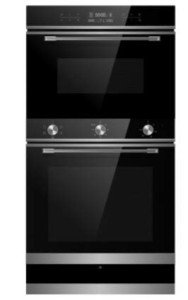25 Surprising Facts About Intergrated Oven

Understanding Integrated Ovens: A Comprehensive Guide
In the realm of cooking innovation, integrated ovens have emerged as a popular device that integrates performance, benefit, and design. As home cooking develops, incorporating modern solutions into kitchen areas has actually ended up being increasingly preferable. This article explores what integrated ovens are, their functions, benefits, and comparisons to traditional ovens.
What is an Integrated Oven?
An integrated oven is a built-in kitchen home appliance created to fit flawlessly within kitchen cabinetry. Unlike freestanding ovens, which inhabit flooring space and are typically large, integrated ovens are developed to be concealed behind kitchen doors, developing a streamlined appearance. These ovens are often part of a total kitchen suite and can include options like convection, steam, and mix ovens, offering versatility for different cooking requirements.
Key Features of Integrated Ovens
- Space-saving Design: Integrated ovens inhabit less square video footage while supplying adequate cooking area, making them perfect for small kitchens.
- Aesthetic Appeal: They mix harmoniously with cabinets, adding to a cohesive kitchen style.
- Multiple Cooking Functions: Many integrated ovens come with numerous cooking modes, including baking, barbecuing, steaming, and more, catering to varied culinary methods.
- Smart Technology: Features like touchscreens, Wi-Fi connectivity, and programmable settings enhance user convenience and precision.
- Energy Efficiency: Many integrated ovens are designed to use energy more effectively than standard ovens, minimizing electrical power usage and cooking times.
Types of Integrated Ovens
Integrated ovens are available in various types, each developed to suit different cooking styles and choices:
- Single Ovens: The most common type for everyday cooking and baking.
- Double Ovens: Suitable for tasks requiring simultaneous cooking at various temperatures.
- Steam Ovens: Ideal for health-conscious cooking, protecting nutrients while ensuring moisture.
- Microwave Ovens: Often integrated with other ovens for flexibility and fast cooking.
- Combi Ovens: Hybrid systems that integrate traditional and steam cooking, providing an exceptional all-in-one option.
Advantages of Integrated Ovens
The benefits of integrated ovens extend well beyond their contemporary looks. Here are some noteworthy benefits:
- Enhanced Kitchen Design: They offer a streamlined, modern-day look that improves the general kitchen visual.
- Improved Functionality: The range of cooking methods and features deals with flexible cooking needs.
- Increased Value: Integrated appliances can increase home worth, making homes more attractive to prospective buyers.
- Alleviate of Use: Intuitive controls and features streamline the cooking process, permitting greater cooking expedition.
- Safety Features: Many integrated ovens include additional safety functions to prevent accidents, specifically essential in household homes.
Comparison Table of Integrated Ovens vs. Traditional Ovens
| Function | Integrated Ovens | Conventional Ovens |
|---|---|---|
| Style | Built-in, seamless with cabinetry | Freestanding, takes up space |
| Cooking Functions | Several (frequently customizable) | Generally basic performances |
| Area Efficiency | Optimized for small cooking areas | Requires more area around the unit |
| Energy Efficiency | Frequently more energy-efficient | Can differ considerably |
| Smart Technology | Numerous designs consist of clever integration | Conventional ovens often lack smart features |
| Aesthetic Appeal | Modern, integrated into the kitchen design | More visible, can interfere with style |
Factors to consider Before Purchasing an Integrated Oven
Picking the right integrated oven involves numerous important elements:
- Space Availability: Before purchase, determine your available kitchen space to ensure a good fit.
- Cooking Needs: Identify what types of cooking you often do to pick the suitable features.
- Spending plan: Integrated ovens differ significantly in rate, so budget factors to consider are crucial.
- Setup Requirements: Professional installation might be required, including to the total expense.
- Brand Reliability: Research brand names and read reviews to guarantee you select a reliable producer.
Often Asked Questions (FAQs)
1. Are integrated ovens more costly than conventional ovens?Yes, integrated ovens tend to be more pricey upfront due to their advanced technology and style. However, they can boost the total value of your kitchen. 2. Can integrated ovens be set up anywhere?No, integrated ovens require to fit within particular kitchen cabinetry styles. gas oven and hob built in to plan your kitchen layout before choosing an integrated oven. 3. Do integrated ovens require professional installation?While built in oven and hob electric may choose to set up integrated ovens themselves, professional installation is usually recommended to make sure security and appropriate function. 4. How do
I keep my integrated oven?Regular cleaning is essential. Use the self-cleaning function (if available ), and keep the oven doors and racks clean after each usage.
5. Can I link my integrated oven to smart devices?Many modern-day integrated ovens are designed with clever features, enabling you to control them through smart device or voice commands. Integrated ovens represent the next evolution in kitchen appliances, integrating modern style with advanced cooking technology. They not just enhance the kitchen's visual appeal however likewise offer flexible cooking performances suited for various culinary skills and choices. Choosing gas oven and hob built in integrated oven needs cautious factor to consider of space, cooking needs, and budget, but the prospective advantages, consisting of boosted kitchen looks and increased home worth, often make them a rewarding investment. With the ideal integrated oven, cooking enthusiasts can elevate their cooking experience to brand-new heights.

